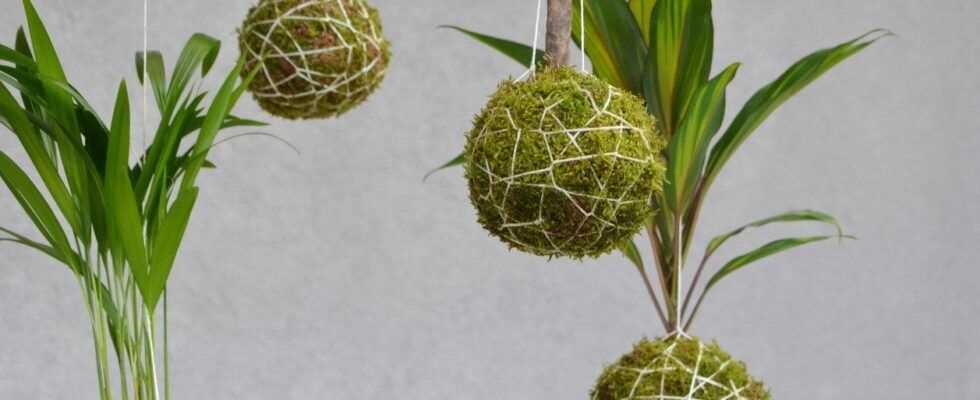Suspended or simply in a ball to pose, kokedamas are plant creations straight from Japan and which grow in a piece of foam. How do you turn a simple little plant into a pretty kokedama? We show you with this easy and green tutorial!
Where do kokedamas come from?
Kokedama is the name given to both a Japanese floral art and the plant composition growing in a sphere of moss which illustrates it. The plants grow in a ball of potting soil or substrate depending on the needs of the plant in question. And, like a bonsai, the roots of the plant are constrained, thus contained in the piece of moss, held by a net made of a thick, strong cotton thread.
This manufacturing technique, elevated to the rank of floral art, has its origins in the 1990s when, in Japan, this technique was developed by drawing inspiration from plants from tropical forests that grow in suspension, sheltered from trees, or directly. on the trunks.
This is also the method that is often used to make green walls: growing plants in pieces of moss.
We found a tutorial on how to make your own hanging kokedama.
DIY to make a hanging kokedama
The necessary equipment
• small plants gleaned from the wild near you (eg at the edge of a ditch, with the root)
• clay (black if you use black cotton thread). You can use modeling clay if you don't have it in its natural state.
• potting soil
• sphagnum moss (= a moss easy to find in garden centers, in orchid pots, otherwise use a sphagnum potting soil)
• green moss, found in the woods or in a garden
• a basin
• strong and thick cotton thread, preferably black or colored string
• thin wire
You can also order ad-hoc material, including sphagnum moss online at Amazon.
The realization of your kokedama
STEP 1. Put your clay to soak for a few hours to soften it.
STEP 2. It is during this time that you can walk in the forest to dig up your small plants and take off sheets of moss in the woods. The choice of your plant is decisive for its maintenance.
STEP 3. On your return, you can get started! In your basin, form a paste with 1/3 clay, 1/3 potting soil and 1/3 sphagnum moss in the basin, and knead well to obtain a homogeneous paste.
STEP 4. Gently remove the soil that remains around the roots of the plant you have chosen for your kokedama. Use a thin wooden stick (a piece of thin stake or a food stick) to clear this soil as delicately as possible.
STEP 5. Then wrap them in clay / sphagnum / compost paste to form a small ball and wrap in the fresh moss that you have collected.
STEP 6. Hold this foam with the cotton thread or string, forming a mesh around the sphere like a net, and knot well so that it stays in place.
STEP 7. Secure the wire around this mesh or pass it through the sphere in order to hang it.
STEP 8. Water your kokedama from the start, because baring your plant and handling the moss will dry them out.
Good plan
We found this tutorial in a very nice book, which offers a lot of very varied DIYs, in order to make yourself decorative objects, body care products, etc.
>> Well-being, do everything yourself, by Raphaëlle Vidaling, Tana editions. You can find this book on Amazon.
Maintaining your kokedama
Of course, depending on the type of plant you "kokedama-ized", the maintenance differs. Generally, however, you need to keep the foam moist. Because the moss must continue to live, and remain green in order to preserve a good level of humidity. It must therefore be watered, but be careful, it is not however a question of soaking it.
> To water your hanging kokedama, use a spray bottle of water at room temperature and diffuse a few sprays every day, just to keep the humidity in place.
> If you have made a posed kokedama, you can place your ball on a layer of clay balls or a clay tray, which keep a good level of humidity.
Warning: if you immerse your ball from time to time for watering, make sure to drain it well, because too much water can rot the roots contained inside.
Either way, touch your kokedama daily, and if the moss seems to be drying out, water!
You will also have to think about the location of your kokedama: not above a radiator which would dry it out, nor in drafts. The nature of your plant (undergrowth plant, full sun plant?) Also determines the level of watering required. When in doubt, opt for a plant that is easy to maintain at the base.
Our advice: for a hanging kokedama, choose a hanging plant, such as an ivy for example.
To see also:
What indoor plants for your bedroom?
The pros of kokedama
Some kokedamas are arranged in pots, but nonetheless remain vegetable balls in a coat of moss, as evidenced by the creations of Jeremiah Seguda. You can find out more on the "Japanese Inspirations" Facebook page.
In the Parisian boutique Ikebanart, located in the Canal Saint-Martin district, you will also find tips, advice, what to make your kokedamas and creations. The store also sometimes organizes dedicated workshops.
More info here.
Finally, another expert: Adrien benard, an agricultural engineer by training, has also made a specialty of kokedamas. Very focused on the quality of the substrate to be used, the water, the light to be provided, the ambient temperature, he also organizes workshops in Colombes, at Aquaphyte.
More info here.
More ideas for your indoor plants in video:
